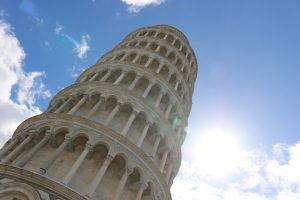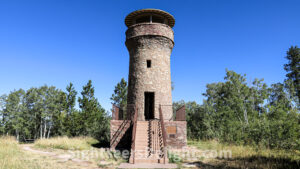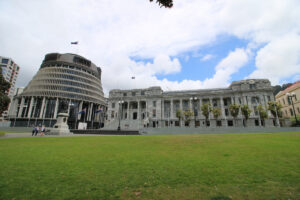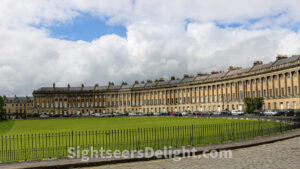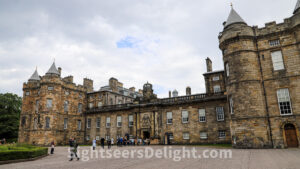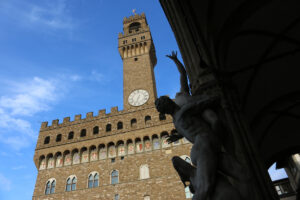Construction on La Torre di Pisa began in August 1173, and at first the tower did not have a tilt. It wasn’t until workers completed three floors of the tower that its now-famous lean was noticeable, leading to a halt in construction. In 1273, work on the tower began again. However, it wasn’t until 1360 that the tower was completed.
The historic Metuchen train station was built in 1888.
The Mount Theodore Roosevelt Monument, also known as the Roosevelt Friendship Monument or Friendship Tower, is a 31-foot-tall stone tower in the Black Hills National Forest near Deadwood, Lawrence County, South Dakota. The monument is a tribute to Theodore Roosevelt, a deputy sheriff in Medora, North Dakota, in 1884. He became lifelong friends with Seth Bullock, who was the Sheriff of Deadwood at the time, and when Roosevelt passed away, Bullock wanted to erect a monument in his honor. The Society of the Black Hills Pioneers helped build the tower, which was dedicated on July 4, 1919. It donated the tower to the United States Forest Service in 1966. In 2010, a restoration project included foundation stabilization and stone repair. Stairs were added to the monument leading up to the platform, and handrails were installed on the stairs and the platform. The Deadwood Historic Preservation Commission, the Black Hills Parks and Forest Association, and the Black Hills National Forest helped restore the monument.
57732
New Zealand Parliament is comprised of a series of buildings, including the recognizable Beehive. The complex also includes the Edwardian neoclassical-style Parliament House, which dates to 1922. For anyone interested in learning more about the New Zealand Parliament, visitors can take a tour of the complex. Tour guides offer a history of the legislative body and bring visitors to committee rooms and the floor of parliament.
A famous semicircle row of Georgian townhouses was built based on designs by architect John Wood the Younger between 1767 and 1774. One of the houses, the No. 1 Royal Crescent, has been preserved as a museum, giving visitors a window into 18th century life. Complete with authentic furniture and artifacts, each room tells a story of daily life 300 years ago. In one of the rooms, the Gentlemen’s Retreat, visitors can learn more about Henry Sandford, the townhouse’s first resident who lived here from 1776 until 1796.
Construction on the Ohio Statehouse started in 1839, and the structure was completed in 1861 and is considered to be a significant architectural accomplishment. The edifice, the seat of Ohio’s government, has been restored to its 1861 appearance. To learn more about the Buckeye State can venture to the Ohio Statehouse Museum Education Center on the ground floor of the statehouse. Visitors can participate in a tour or wander the museum at their own pace. A monument to President William McKinley, a native of Niles, Ohio, stands in front of the statehouse.
43215
Old Sarum is an abandoned hill fort dating that was likely established in 400 BC. The Romans later used the site and created the town of Sorviodunum. A trio of Roman roads converged near the site, making it an essential strategic location. Following the Norman conquest of England in 1066, the city was expanded, but it was largely abandoned in the 13th century. The bishop of Salisbury, Osmund de Sees, completed a small cathedral at the site in 1092. Little is left of the city, as much of the original construction in Old Sarum was demolished after Henry VIII sold the rights to the castle’s remains in 1514.
The Palazzo Pitti or Pitti Palace dates to 1458 and was the town residence of Luca Pitti, a Florentine banker. The Medici family bought the place, which is on the south side of the River Arno, a short distance from the Ponte Vecchio, in 1549. It served the main home of the ruling families of the Grand Duchy of Tuscany and grew as a great treasure house. Later generations amassed paintings, plates, jewelry and luxurious possessions. Napoleon used the palace in the late 18th century, and King Victor Emmanuel III donated the building and its contents to the Italian people in 1919.
Palazzo Vecchio, which translates to Old Palace, is Florence’s town hall. The historic edifice is adjacent to the Piazza della Signoria and a copy of Michelangelo’s famed David statue; the Galleria dell’Accademia houses the original. It also overlooks the Loggia dei Lanzi, effectively an outdoor art gallery. Visitors who hike to the top of the Palazzo Vecchio’s bell tower are rewarded with stunning views of the city.

